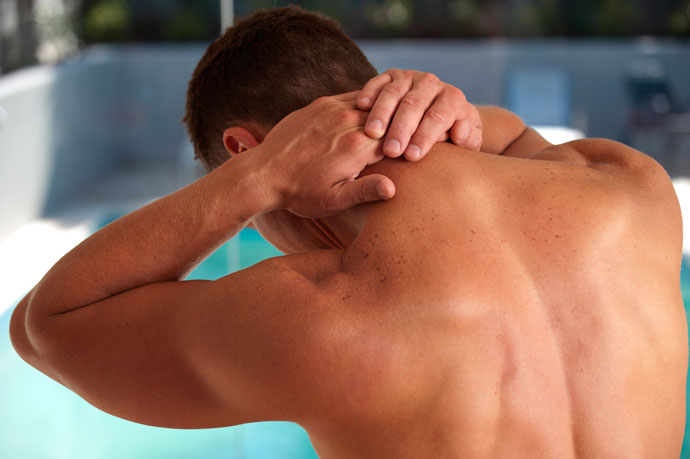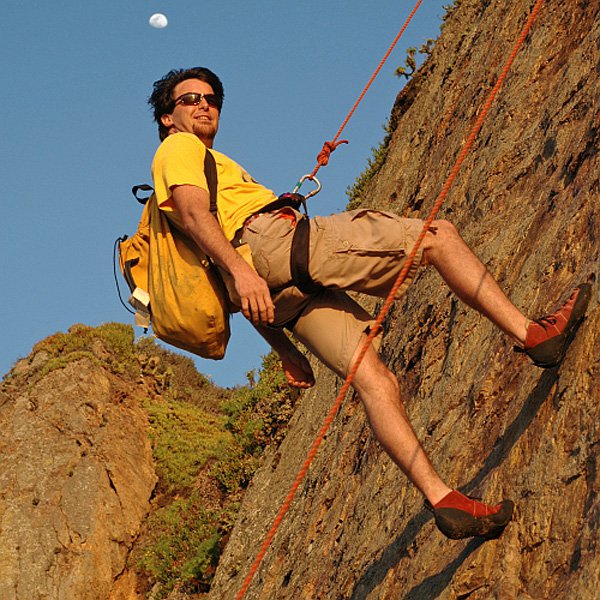This article describes common causes of neck swimming injuries and what you can do to prevent them.

Swimming is one of the best physical exercises as it engages the whole body and is easy on the joints. However, swimming-related injuries do occur, and the neck can be one of the targets of such an injury. Injuries to the neck are often due to overuse associated with bad swimming technique or through accidental collisions in the pool.
Swimming injuries to the neck can be caused by incorrect motions repeated thousands of time over the course of several years. That’s why correct swimming technique is important. Each stroke has its own peculiarities which we’ll look into now.
TopSync
In the past, a high head position with the eyes looking forward was often advised in the freestyle stroke. However, this doesn’t bring any hydrodynamic advantage yet strains the neck. Instead you should keep the head aligned with the spine. The ideal position is with the face parallel to the water surface and the eyes looking towards the bottom of the pool.
When you breathe in, another source of neck swimming injuries can be when you over rotate or lift the head. To correct this, you should instead rotate the whole body towards the breathing side and avoid lifting the head.
A slight rotation of the head is normally sufficient to catch air, as the head creates a bow wave whose trough is located besides the mouth. The professionals call this breathing in the pocket. You can train this by keeping one lens of the goggles in the water during the inhale.
Exhaling should be done continuously in the water, as there isn’t enough time to both inhale and exhale while the head is rotated to the side. This minimizes the time needed to rotate the head and as a consequence reduces neck strain.
Finally, it is important to use bilateral breathing as the standard breathing pattern. This avoids muscular imbalances which can also affect the neck.
In the backstroke, breathing mechanics are more simple. Basically, the head should always stay aligned with the spine, with the face parallel to the water surface and the swimmer looking straight up towards the ceiling. This head position allows for easy breathing.
Yet this position has also its pitfalls. In the backstroke, the head is buoyed up by the water and this puts the anterior neck muscles under pressure. That’s why it is important to gradually increase the yardage so that the neck muscles have time to grow stronger.
Swimming breaststroke with the head above water should be avoided because it continuously puts the neck under pressure. Instead, let the head glide back down in the water after the inhale and exhale continuously in the water.
Another mistake many breaststroke swimmers do is that they look at the end of the pool during the inhale phase. This overextends the neck and can lead to swimming injuries. Instead it is better to look down and slightly to the front.
The guidelines to avoid neck injuries in the butterfly stroke are similar to those of the breaststroke: you should keep the head aligned with the spine, avoid jerking motions and look down and slightly to the front during the inhale phase. Exhaling should be continuous while the head is in the water.
I’ve seen butterfly swimmers rotate the head to the side while breathing in. I’ve been told that it allows to keep a better body wave rhythm. However I think it puts the neck in an awkward position and is better avoided.
When doing flip turns, it is important to not overextend the head at the start of the turn. Instead you should tuck the head in.
BottomSync
Diving is one of the first causes of swimming-related head and neck injuries. Those injuries occur when swimmers dive in shallow or unfamiliar waters or have improper diving technique. This leads to head-first collisions with the ground, pool walls or invisible obstacles lurking in the water.
Such collisions can lead to brain injuries and damage the cervical spine and the spinal cord. Needless to say, these injuries can be serious and even life-threatening. That’s why you should never dive in shallow water (less than 12 foot deep) or in unfamiliar bodies of water.
A backstroke swimmer can collide into pool walls or with another swimmer as he has no vision to the front. To avoid this, it’s best to switch to a circling pattern as soon as there are more than two simmers inside a lane. Bumping into pool walls can be avoided by paying attention to the backstroke flags. Those signal that the pool end is near.
The neck is a weak structure in the human body. Therefore it is important to pay attention to correct swimming technique and to observe responsible behavior when diving. If you follow the advice in this article, your neck should stay clear of swimming injuries and you should be able to enjoy swimming for many years to come.
Indoor Baseball Drills Keep You Active And Sharp

Viper HS Rifle scope, A Sane Choice If You Are The Budgeted Buyer

Great bait tips: crust and honey

Copyright © www.mycheapnfljerseys.com Outdoor sports All Rights Reserved